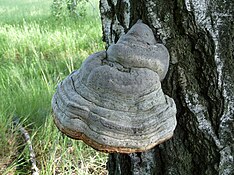Fomes fomentarius
| Fomes fomentarius | |
|---|---|
 |
|
| Scientific classification | |
| Kingdom: | Fungi |
| Division: | Basidiomycota |
| Class: | Agaricomycetes |
| Order: | Polyporales |
| Family: | Polyporaceae |
| Genus: | Fomes |
| Species: | F. fomentarius |
| Binomial name | |
|
Fomes fomentarius (L.) Fr. 1849 |
|
| Synonyms | |
|
Species synonymy
|
|
Fomes fomentarius (commonly known as the tinder fungus, false tinder fungus, hoof fungus, tinder conk, tinder polypore or ice man fungus) is a species of fungal plant pathogen found in Europe, Asia, Africa and North America. The species produces very large polypore fruit bodies which are shaped like a horse's hoof and vary in colour from a silvery grey to almost black, though they are normally brown. It grows on the side of various species of tree, which it infects through broken bark, causing rot. The species typically continues to live on trees long after they have died, changing from a parasite to a decomposer.
Though inedible, F. fomentarius has traditionally seen use as the main ingredient of amadou, a material used primarily as tinder, but also used to make clothing and other items. The 5,000-year-old Ötzi the Iceman carried four pieces of F. fomentarius, concluded to be for use as tinder. It also has medicinal and other uses. The species is both a pest and useful in timber production.
The first scientific description of the fungus appeared in the literature in the 1753 Species Plantarum by Carl Linnaeus; he called it Boletus fomentarius. The specific epithet fomentarius is from the Latin , referring to tinder. The species has been described as a member of numerous different genera. In 1783, Jean-Baptiste Lamarck named the species Agaricus fomentarius in his Encyclopédie Méthodique: Botanique. In 1818, Georg Friedrich Wilhelm Meyer described Polyporus fomentarius in his Primitiae Florae Essequeboensis, and this name was sanctioned by Elias Magnus Fries in the 1821 publication of the first volume of his Systema Mycologicum. Fries later, in his 1849 Summa vegetabilium Scandinaviae, moved the species to the genus Fomes. Subsequent attempts to change the genus of the species have been unsuccessful; the species was named Placodes fomentarius by Lucien Quélet in 1886, Ochroporus fomentarius by Joseph Schröter in 1888 and Scindalma fomentarium by Otto Kuntze in 1898. In the twentieth century, Narcisse Théophile Patouillard named the species Ungulina fomentaria in 1900, and William Murrill twice reallocated the species; in 1903, he named it Elfvingia fomentaria and in 1914, he named it Elfvingiella fomentaria. In 1963, Shu Chün Teng named it Pyropolyporus fomentarius. These names are considered obligate synonyms; that is, different names for the same species based on a single description or specimen. In addition to the obligate synonyms, there are a number of taxonomic synonyms, whereby names have been described as separate species, but have come to be considered synonymous. The species is commonly known as the tinder fungus, hoof fungus, tinder polypore, ice man fungus or false tinder fungus.
...
Wikipedia
